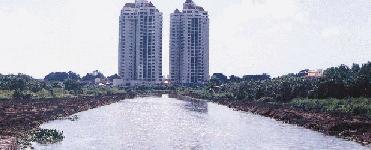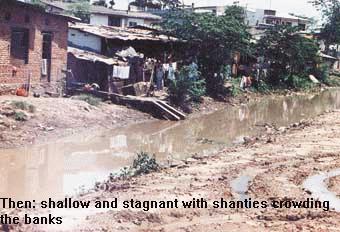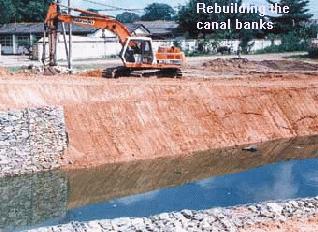

![]()

Colombo’s canals have, at last, acquired a new look. The project to upgrade the ancient canal system which took off four years ago is now near completion and the results are obvious to all. The silted, incredibly polluted, stagnating pools of water of yesteryear are no more. The shanties that crowded the banks, making the canals such an eyesore are no longer there. Today what is seen are wide expanses of water that actually flow, neatly constructed banks and boundaries. Several new bridges too have been built and finally these canals are ready to take on the task of controlling floods in the city.
The need to clean up the canals arose when Colombo experienced its most daunting flood of recent times in 1992. Now with the threat of such a flood minimised, the government is looking at ways of utilising the canals for other purposes. This would serve as ways of generating revenue through the canals, which could be channeled back for their upkeep. The list of planned activities on the canals include boat transport, canal tours for tourists, sports activities like rowing and restaurants both of the floating type and permanent on canal banks.
The Land Reclamation Corporation, the authority overseeing the canal project, has called for private sector participation in these activities by way of advertisements. The corporation claims they are pleased with the response and interest shown by the private sector in investing in the new-look canals.
In 1992, the Land Reclamation and Development Corporation managed to secure funding from the Japanese OECF (Overseas Economic Corporation Fund) to undertake this massive project of cleaning up the 33 kilometres of canal ways. The Japanese Government pledged a 11 billion yen loan which at the time was the largest provided by the Japanese government to a single project in Sri Lanka. The state provided funds for relocation and compensation for acquired land. Under the project several new bridges too have come up and eight kilometres of new canal which connect the existing network to the Kelani river at Ambatale.
The task of cleaning the silted, polluted waterways which not only bred mosquitoes but also nefarious activities was spurned by the shanty dwellers who lived along the banks. To remove the 5,565 families from the canals was not an easy task. It took years to complete the evacuation and resettle these families, and as yet there are a few families to be moved. The canals were then dredged for depth and the banks widened. The shanties were torn down and in their place came grassy slopes and roadways. The bunds were reconstructed- different types of reinforcement used at the various locations. Sheet piling, gabions (granite packed into steel cases) or gravel slopes. While the entire lengths of Dehiwala, Wellawatte, Torrington canals are now ready, still some parts of St. Sebastian’s canal and Main Drain in Modera are yet to be tackled. "By January 1998 we will complete these areas," Godwin Withana, Chairman SLRDC (Sri Lanka Land Reclamation and Development Corporation) said.

 The
project, Greater Colombo Flood Control and Environment Improvement Project,
will continue even after this. Two more phases of the project, aiming at
improving flood control in localised areas and upgrading municipal storm water
drainage systems will continue until year 2003, funded again by the Japanese
Government.
The
project, Greater Colombo Flood Control and Environment Improvement Project,
will continue even after this. Two more phases of the project, aiming at
improving flood control in localised areas and upgrading municipal storm water
drainage systems will continue until year 2003, funded again by the Japanese
Government.
But although the canals are dredged and widened, yet the water quality needs to be improved drastically if any kind of commercial activities are to occur. The water still looks dark and murky. Although no piles of garbage are dumped into the water, occasional dirt and litter is not unusual. It is obvious that there are still pollutants flowing into the waterway. "The Petroleum Corporation in Kolonnawa expels waste into the canals and the storm water drains which connect into the canals are sometimes contaminated by sewage," said Gemunu Alawattegama, Deputy General Manager of SLRDC.
Alawattegama said that the next step was to improve the water. He said that CEA and the CMC were working with industries that are polluting the canals to work out ways to minimise intrusions into the water. The canals will be fenced off to prevent future encroachments. There also appeared to be a problem of water stagnating during dry weather spells. To counter the lack of flow, the corporation is looking at ways of flushing the canals by either pumping water from the Beira or Kelani or pooling water and releasing periodically to counter stagnation.
At the moment, the canal system has no link with the Beira lake. The only link, at St. Sebastian’s Hill, Pettah has been closed off.
While the project to clean up the Beira is underway, if a little slowly, the canals are certainly on the right road. The obvious change in looks would have prompted the interest shown by the private parties on investing in the canals and their future. Upto last week some 31 proposals for canal activities had been received by the Corporation. Mr. Withana said that even citizens residing near canals who wanted to use a boat for travelling or transportation could do so. This would be possible through a licensing scheme where users of the canal space would be asked to pay a fee as rental.
Larger operations like restaurants and tour boats would also work on this basis. To make sure that the canals are not polluted by these external activities, strict monitoring will ensue, but as Withana put it, "It will be in the interest of the entrepreneur to keep the canals clean for his business would depend on how good the waterways look."
Continue to Plus page 9 -Looking for other icons
Return to the Plus contents page
![]()
| HOME PAGE | FRONT PAGE | EDITORIAL/OPINION | NEWS / COMMENT | BUSINESS
Please send your comments and suggestions on this web site to
info@suntimes.is.lk or to
webmaster@infolabs.is.lk